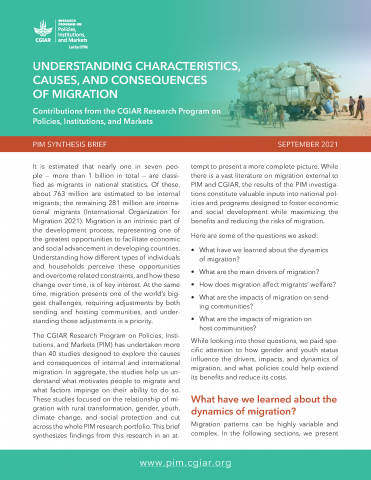Understanding characteristics, causes, and consequences of migration: Contributions from the CGIAR research program on policies, institutions, and markets
Abstract
It is estimated that nearly one in seven people — more than 1 billion in total — are classified as migrants in national statistics. Of these, about 763 million are estimated to be internal migrants; the remaining 281 million are international migrants (International Organization for Migration 2021). Migration is an intrinsic part of the development process, representing one of the greatest opportunities to facilitate economic and social advancement in developing countries. Understanding how different types of individuals and households perceive these opportunities and overcome related constraints, and how these change over time, is of key interest. At the same time, migration presents one of the world’s biggest challenges, requiring adjustments by both sending and hosting communities, and understanding those adjustments is a priority. The CGIAR Research Program on Policies, Institutions, and Markets (PIM) has undertaken more than 40 studies designed to explore the causes and consequences of internal and international migration. In aggregate, the studies help us understand what motivates people to migrate and what factors impinge on their ability to do so. These studies focused on the relationship of migration with rural transformation, gender, youth, climate change, and social protection and cut across the whole PIM research portfolio. This brief synthesizes findings from this research in an attempt to present a more complete picture. While there is a vast literature on migration external to PIM and CGIAR, the results of the PIM investigations constitute valuable inputs into national policies and programs designed to foster economic and social development while maximizing the benefits and reducing the risks of migration.

